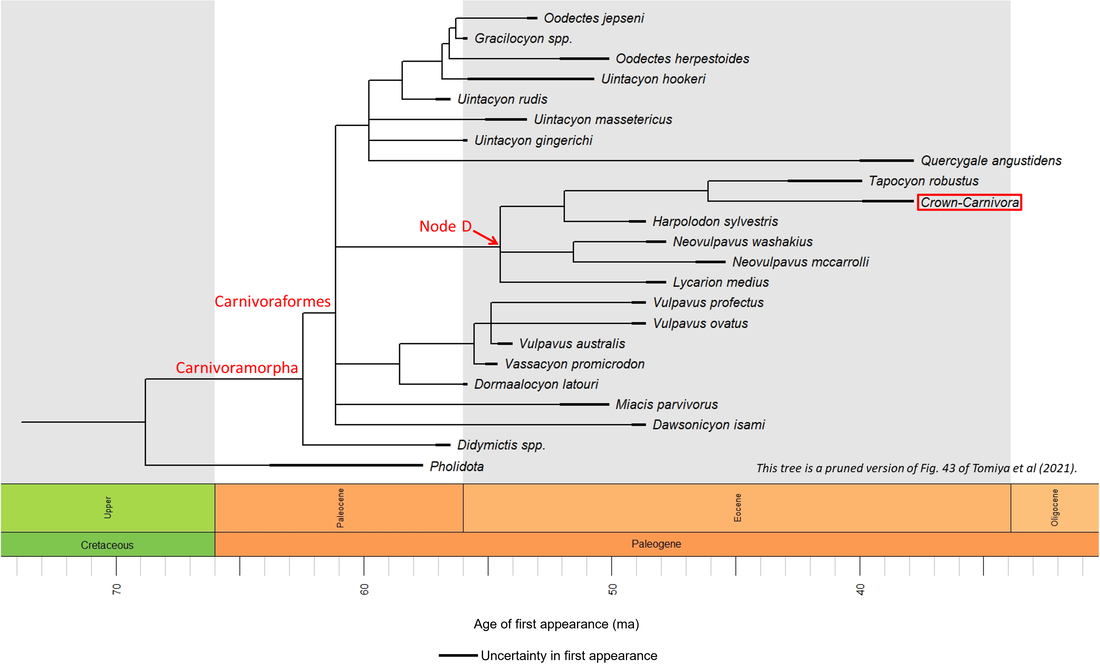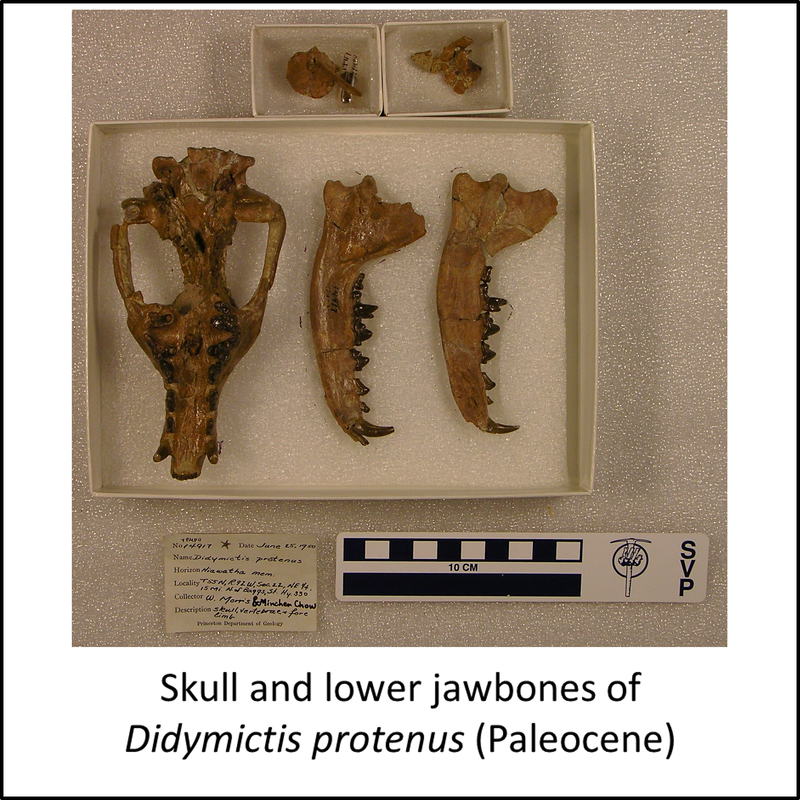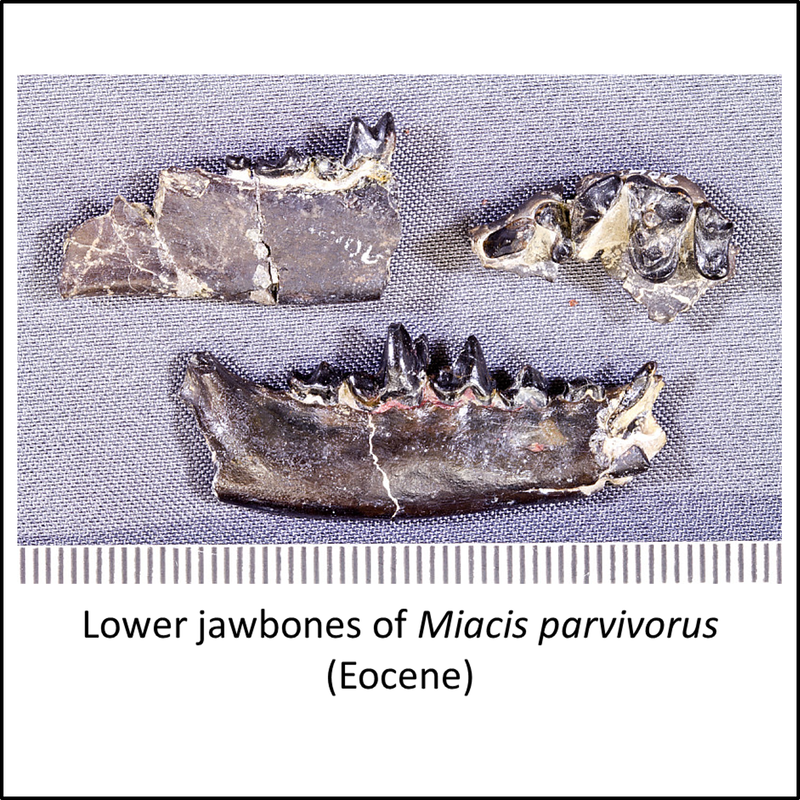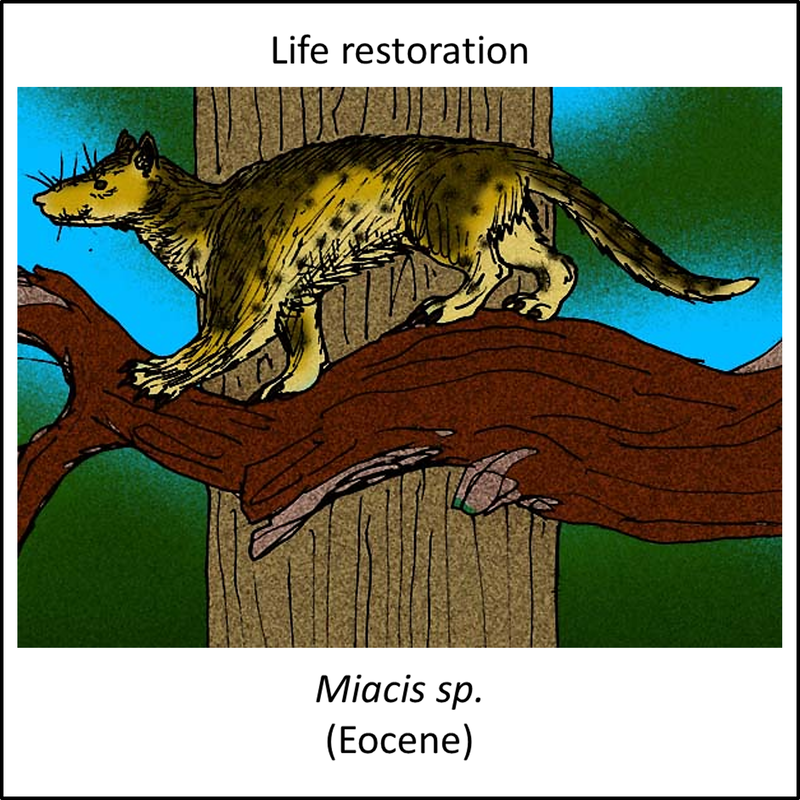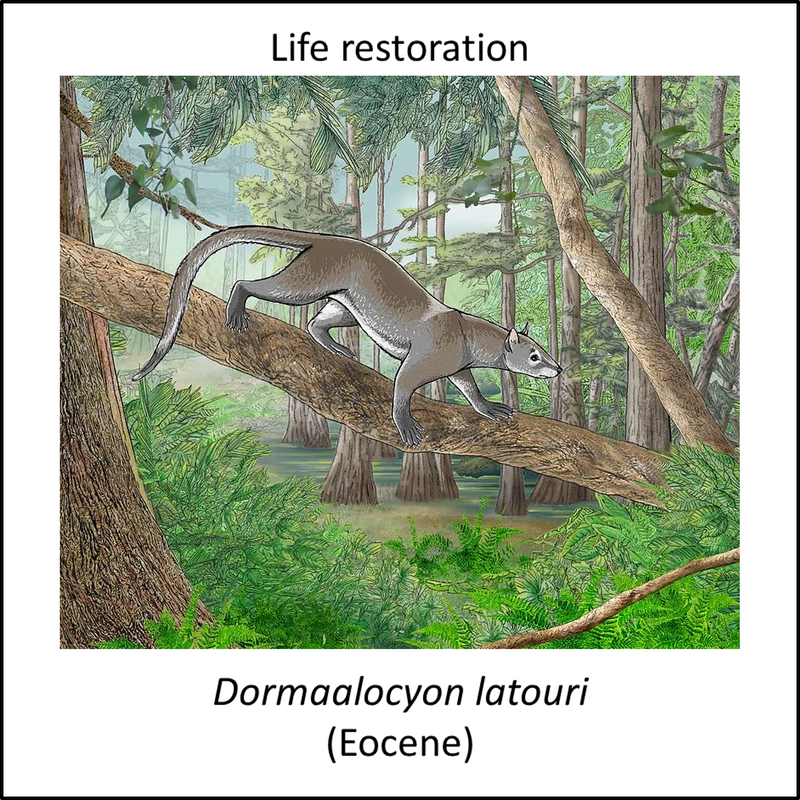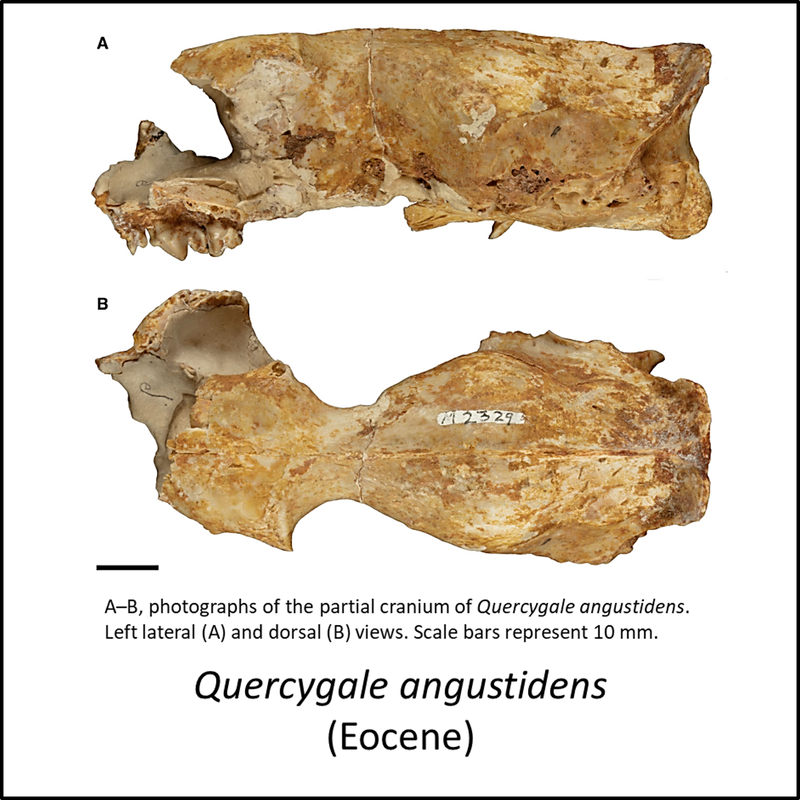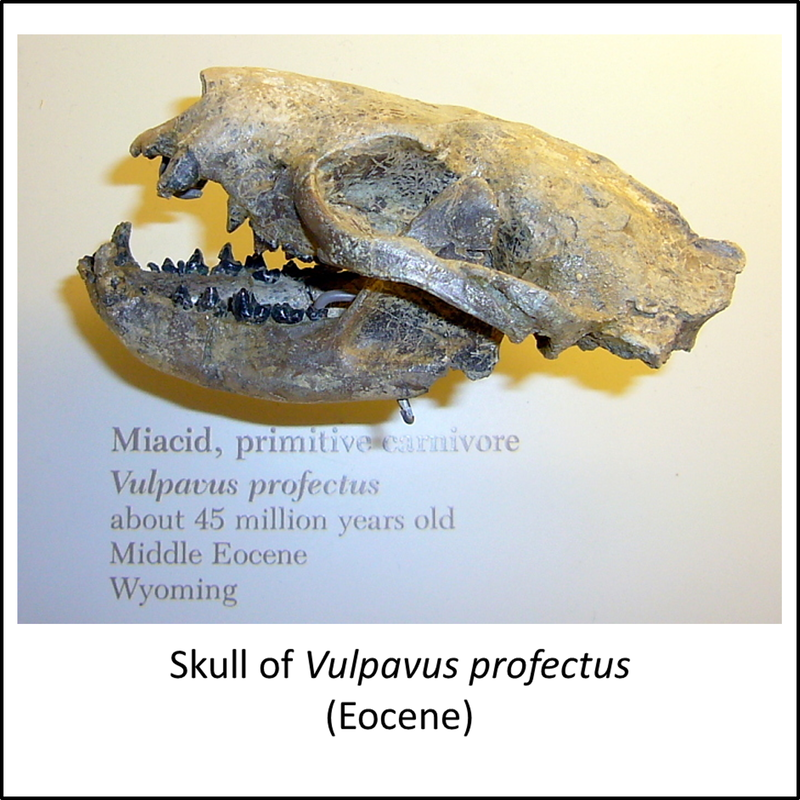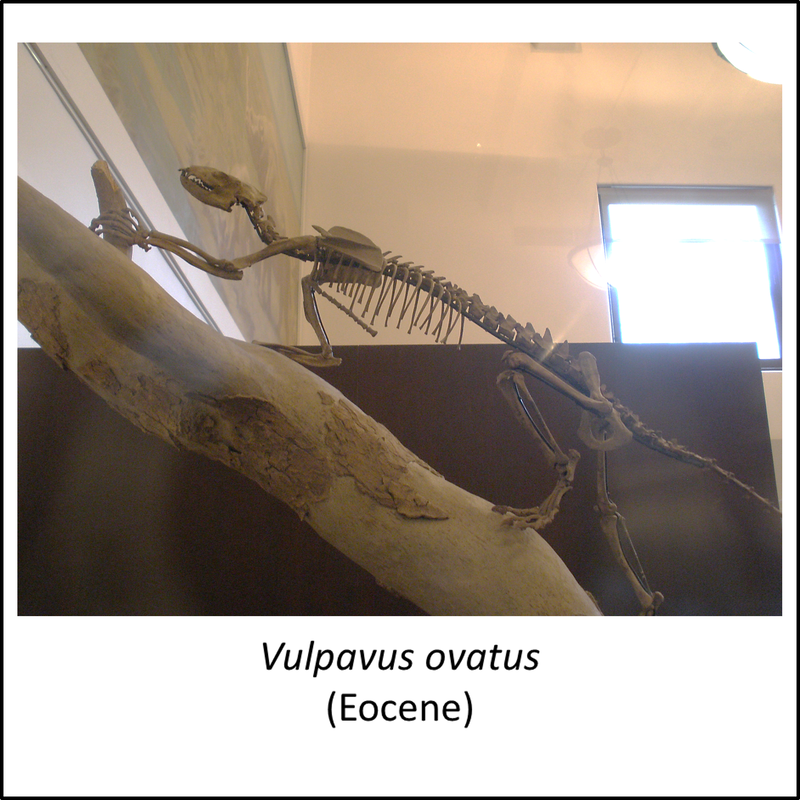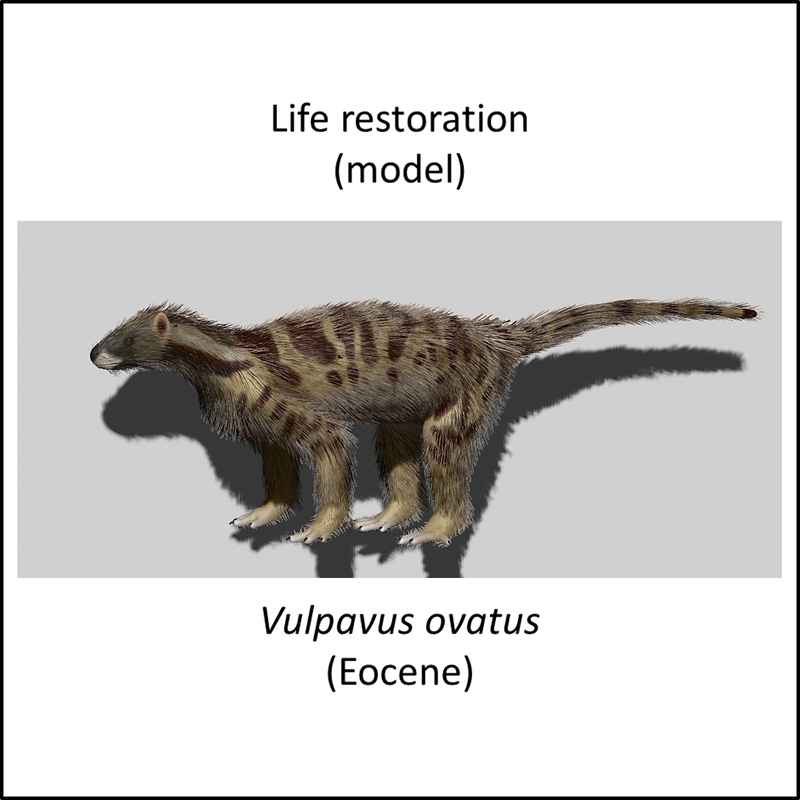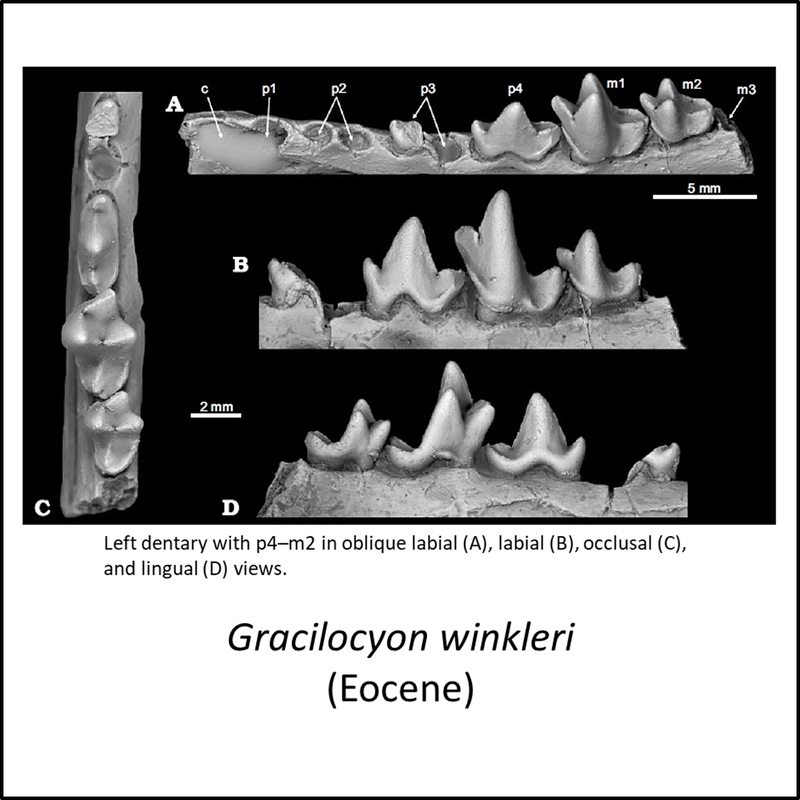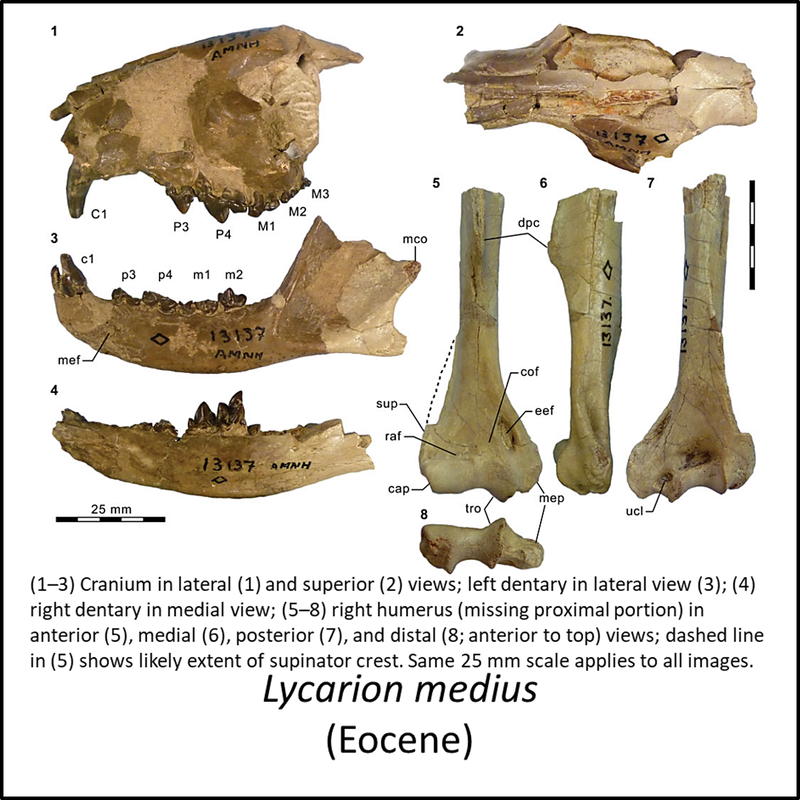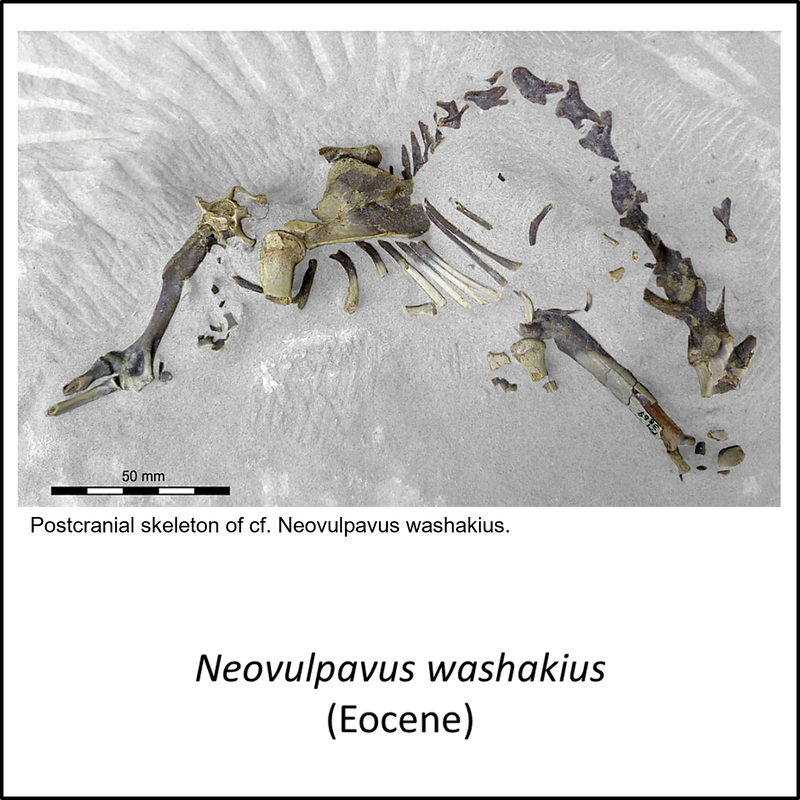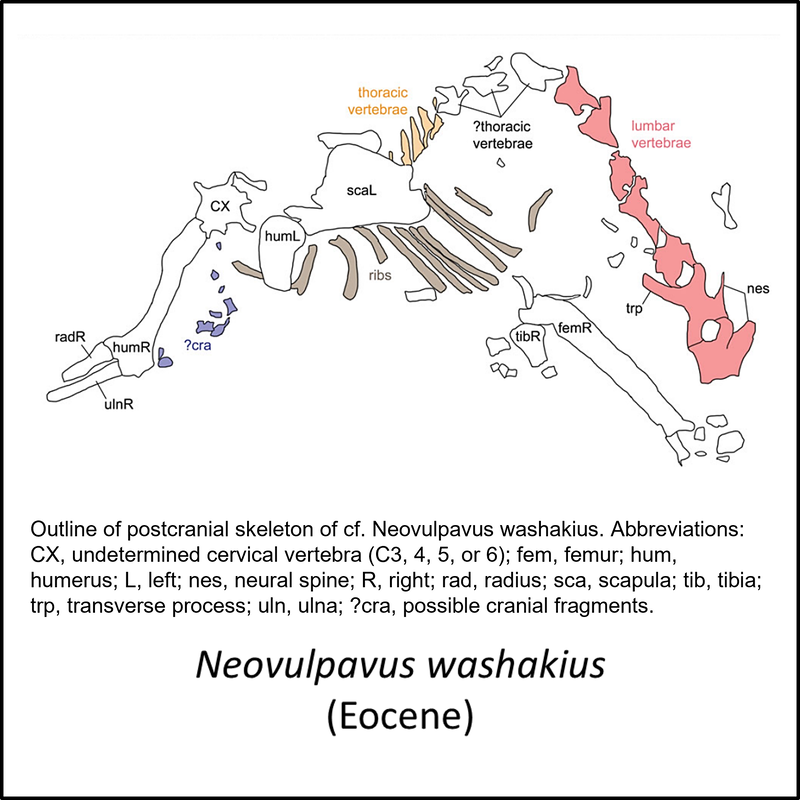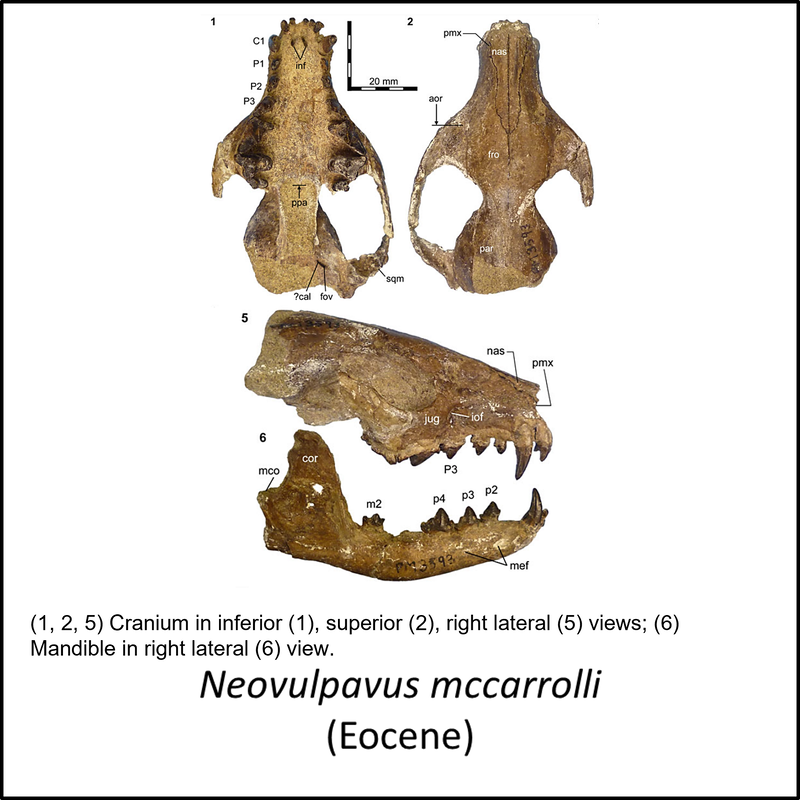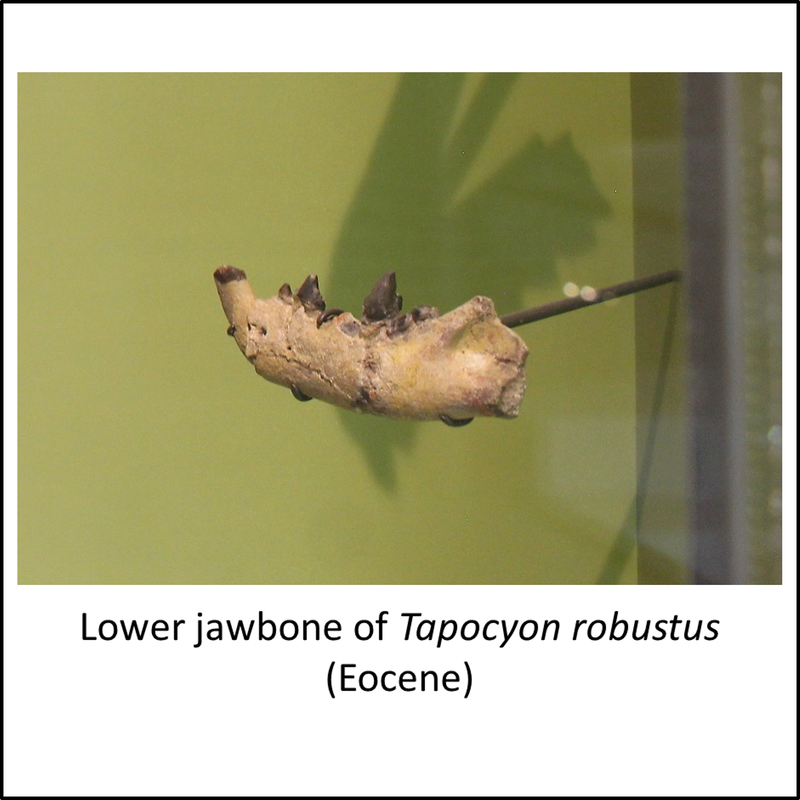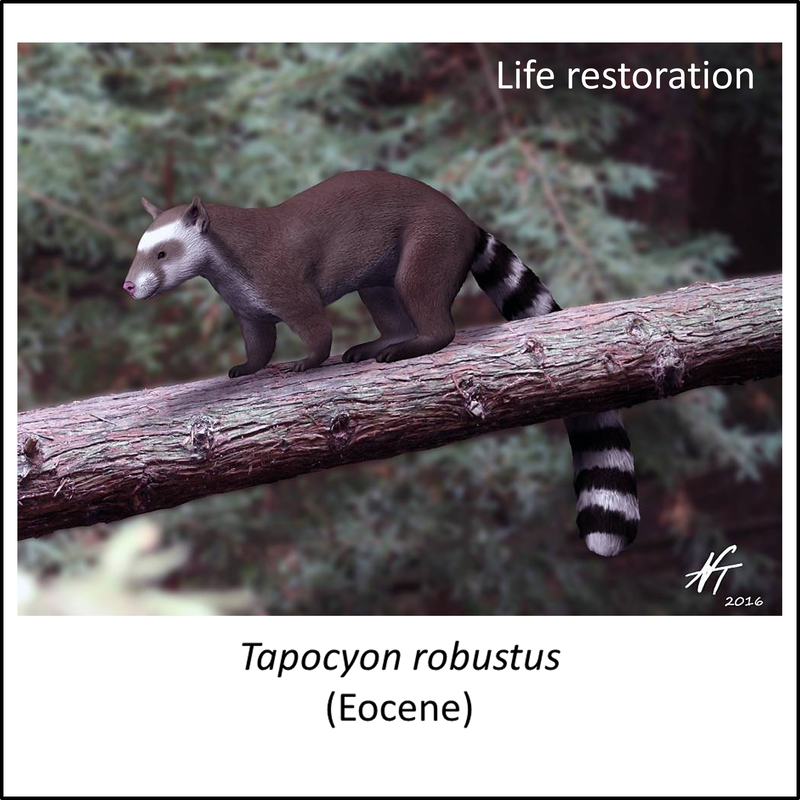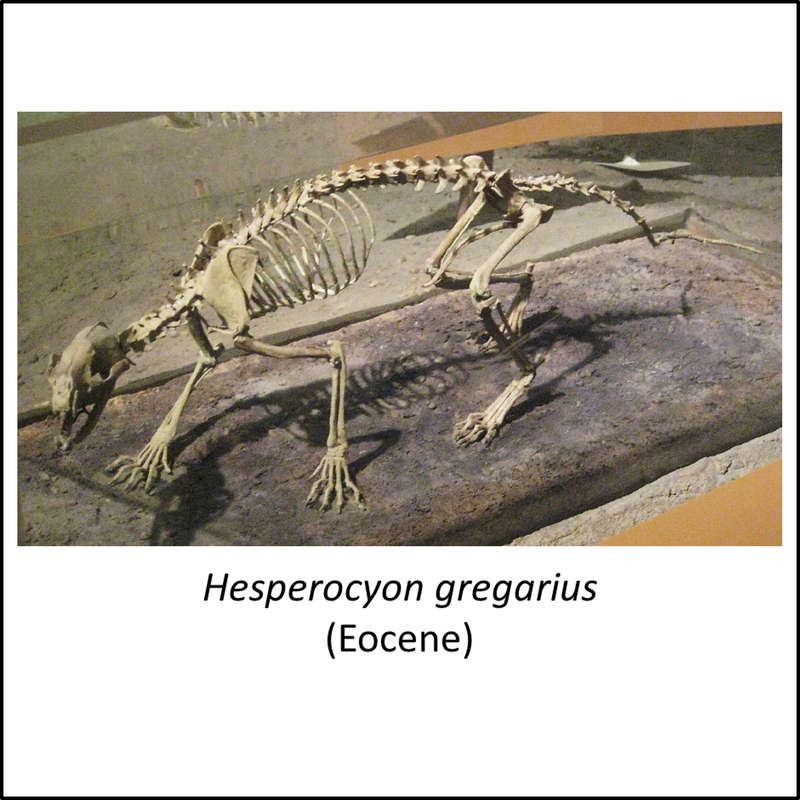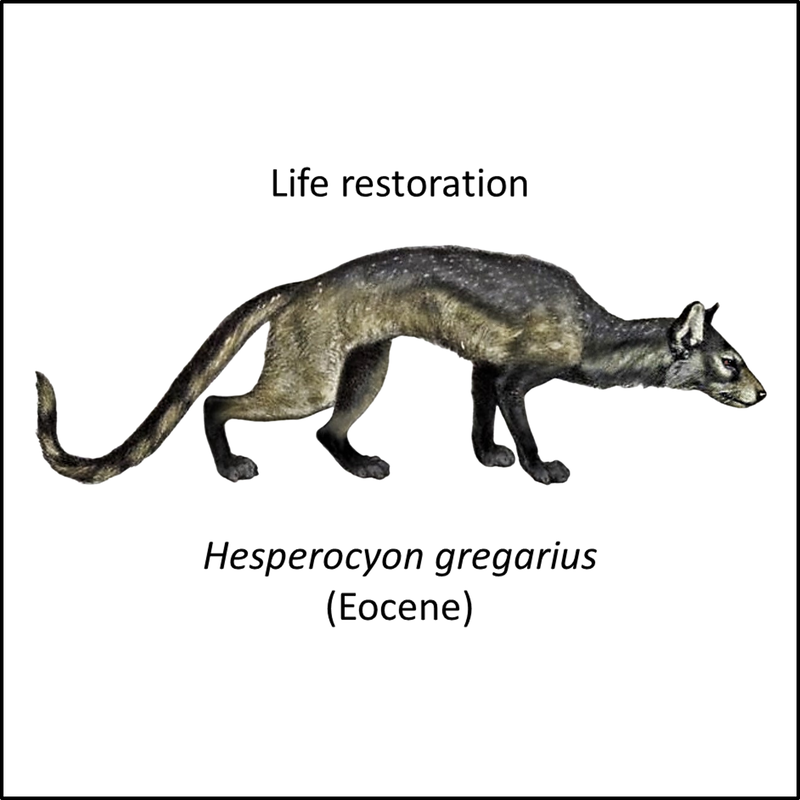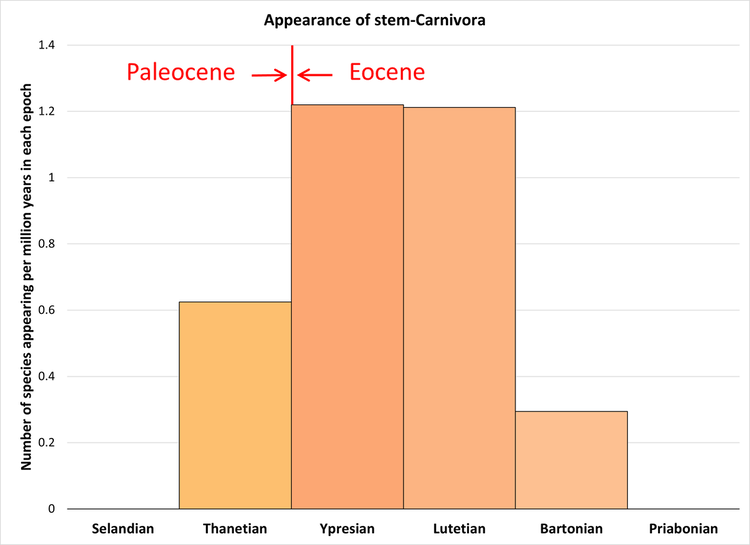The carnivorans (order Carnivora, infraclass Eutheria) form a clade that comprises the cat-like and dog-like animals. The clade contains two sub-orders, the Caniformia (dog-like animals) and the Feliformia (cat-like animals).
Several phylogenetic trees of the Carnivora have been published over the past eight years or so (e.g. Solé et al, 2014; Solé et al, 2016; Tomiya et al, 2021; Flink and Werdelin, 2022), but the most recent study with a good number of stem-group species included is that by Tomiya et al (2021), on which the following time tree is based:
Several phylogenetic trees of the Carnivora have been published over the past eight years or so (e.g. Solé et al, 2014; Solé et al, 2016; Tomiya et al, 2021; Flink and Werdelin, 2022), but the most recent study with a good number of stem-group species included is that by Tomiya et al (2021), on which the following time tree is based:
Figure 1. Time tree of the stem-Carnivora
The oldest known stem-Carnivora are Didymictis spp. (examined as a composite of two very similar species D. protenus and D. vancleveae) and the species Uintacyon rudis, from the Late Paleocene of Wyoming, USA (Tomiya et al, 2021). Skull and lower jawbones of Didymictis protenus are shown below, together with the other fossils shown in Figure 1 for which public-domain images are available (click on image for a larger view):
Figure 2. Images of stem-group carnivorans
The above images are ordered from most basal to most crownward, but most of the images are of partial skeletal remains and no obvious trends in general appearance can be seen. The life restorations all indicate that the stem carnivorans were animals that had a mixture of dog- and cat-like features.
The oldest known member of the crown-Carnivora is Hesperocyon gregarious, which belongs to the stem-Caniformia (Benton et al, 2015; Tomiya et al, 2021). It was found in the Eocene (Bartonian) Cypress Hills Formation near Lac Pelletier, Saskatchewan (Bryant, 1992). A skeleton and a life restoration of the species are shown below (for a larger view, click on image):
The oldest known member of the crown-Carnivora is Hesperocyon gregarious, which belongs to the stem-Caniformia (Benton et al, 2015; Tomiya et al, 2021). It was found in the Eocene (Bartonian) Cypress Hills Formation near Lac Pelletier, Saskatchewan (Bryant, 1992). A skeleton and a life restoration of the species are shown below (for a larger view, click on image):
Figure 3. Hesperocyon gregarious, the oldest known crown-group carnivoran
The available fossil data indicate that the carnivoran stem group developed from Paleocene to mid-Eocene time, representing a stem-to-crown transition of at least 18 million years (see Figure 1). As shown below, the rate of evolutionary change was highest during the Early Eocene (Ypresian) and the earliest part of the Middle Eocene (Lutetian):
Figure 4. Rate of appearance of stem-group carnivorans (predating the crown group and including only the genera shown in Figure 1)
References
Benton, M. J., Donoghue, P. C., Asher, R. J., Friedman, M., Near, T. J., & Vinther, J. (2015). Constraints on the timescale of animal evolutionary history. Palaeontologia Electronica, 18(1), 1-106.
Bryant, H. N. (1992). The Carnivora of the Lac Pelletier Lower Fauna (Eocene: Duchesnean), Cypress Hills Formation, Saskatchewan. Journal of Paleontology, 66(5), 847-855.
Flink, T., & Werdelin, L. (2022). Digital endocasts from two late Eocene carnivores shed light on the evolution of the brain at the origin of Carnivora. Papers in Palaeontology, 8(2), e1422.
Solé, F., Smith, R., Coillot, T., De Bast, E., & Smith, T. (2014). Dental and tarsal anatomy of ‘Miacis’ latouri and a phylogenetic analysis of the earliest carnivoraforms (Mammalia, Carnivoramorpha). Journal of Vertebrate Paleontology, 34(1), 1-21.
Solé, F., Smith, T., De Bast, E., Codrea, V., & Gheerbrant, E. (2016). New carnivoraforms from the latest Paleocene of Europe and their bearing on the origin and radiation of Carnivoraformes (Carnivoramorpha, Mammalia). Journal of Vertebrate Paleontology, 36(2), e1082480.
Tomiya, S., Zack, S. P., Spaulding, M., & Flynn, J. J. (2021). Carnivorous mammals from the middle Eocene Washakie Formation, Wyoming, USA, and their diversity trajectory in a post-warming world. Journal of Paleontology, 95(S82), 1-115.
Bryant, H. N. (1992). The Carnivora of the Lac Pelletier Lower Fauna (Eocene: Duchesnean), Cypress Hills Formation, Saskatchewan. Journal of Paleontology, 66(5), 847-855.
Flink, T., & Werdelin, L. (2022). Digital endocasts from two late Eocene carnivores shed light on the evolution of the brain at the origin of Carnivora. Papers in Palaeontology, 8(2), e1422.
Solé, F., Smith, R., Coillot, T., De Bast, E., & Smith, T. (2014). Dental and tarsal anatomy of ‘Miacis’ latouri and a phylogenetic analysis of the earliest carnivoraforms (Mammalia, Carnivoramorpha). Journal of Vertebrate Paleontology, 34(1), 1-21.
Solé, F., Smith, T., De Bast, E., Codrea, V., & Gheerbrant, E. (2016). New carnivoraforms from the latest Paleocene of Europe and their bearing on the origin and radiation of Carnivoraformes (Carnivoramorpha, Mammalia). Journal of Vertebrate Paleontology, 36(2), e1082480.
Tomiya, S., Zack, S. P., Spaulding, M., & Flynn, J. J. (2021). Carnivorous mammals from the middle Eocene Washakie Formation, Wyoming, USA, and their diversity trajectory in a post-warming world. Journal of Paleontology, 95(S82), 1-115.
Image credits – stem-Carnivora
- Figure 2 (Didymictis protenus): Yale Peabody Museum, CC0, via Wikimedia Commons
- Figure 2 (Miacis parvivorus): https://www.si.edu/object/miacis-parvivorus-cope:nmnhpaleobiology_3379451, CC0, via Wikimedia Commons
- Figure 2 (Miacis sp.): GFDL, CC BY-SA 3.0 <https://creativecommons.org/licenses/by-sa/3.0>, via Wikimedia Commons
- Figure 2 (Dormaalocyon latouri): Charlène Letenneur (MNHN) and Pascale Golinvaux (RBINS), CC BY-SA 4.0 <https://creativecommons.org/licenses/by-sa/4.0>, via Wikimedia Commons
- Figure 2 (Quercygale angustidens): Open Access article Flink, T., & Werdelin, L. (2022). Digital endocasts from two late Eocene carnivores shed light on the evolution of the brain at the origin of Carnivora. Papers in Palaeontology, 8(2), e1422.
- Figure 2 (Vulpavus profectus): https://www.si.edu/object/vulpavus-cf-profectus-matthew:nmnhpaleobiology_3380088, CC0, via Wikimedia Commons
- Figure 2 (Vulpavus ovatus, fossil): Ghedoghedo, CC BY-SA 3.0 <https://creativecommons.org/licenses/by-sa/3.0>, via Wikimedia Commons
- Figure 2 (Vulpavus ovatus, life restoration): Петр Меньшиков, CC BY-SA 4.0 <https://creativecommons.org/licenses/by-sa/4.0>, via Wikimedia Commons
- Figure 2 (Gracilocyon winkleri): Smith Thierry, Smith Richard,, CC BY-SA 4.0 <https://creativecommons.org/licenses/by-sa/4.0>, via Wikimedia Commons
- Figure 2 (Lycarion medius): Open Access article Tomiya, S., Zack, S. P., Spaulding, M., & Flynn, J. J. (2021). Carnivorous mammals from the middle Eocene Washakie Formation, Wyoming, USA, and their diversity trajectory in a post-warming world. Journal of Paleontology, 95(S82), 1-115.
- Figure 2 (Neovulpavus washakius, fossil): Open Access article Tomiya, S., Zack, S. P., Spaulding, M., & Flynn, J. J. (2021). Carnivorous mammals from the middle Eocene Washakie Formation, Wyoming, USA, and their diversity trajectory in a post-warming world. Journal of Paleontology, 95(S82), 1-115.
- Figure 2 (Neovulpavus washakius, life restoration): Open Access article Tomiya, S., Zack, S. P., Spaulding, M., & Flynn, J. J. (2021). Carnivorous mammals from the middle Eocene Washakie Formation, Wyoming, USA, and their diversity trajectory in a post-warming world. Journal of Paleontology, 95(S82), 1-115.
- Figure 2 (Neovulpavus mccarrolli): Open Access article Tomiya, S., Zack, S. P., Spaulding, M., & Flynn, J. J. (2021). Carnivorous mammals from the middle Eocene Washakie Formation, Wyoming, USA, and their diversity trajectory in a post-warming world. Journal of Paleontology, 95(S82), 1-115.
- Figure 2 (Tapocyon robustus, fossil): Jonathan Chen, CC BY-SA 4.0 <https://creativecommons.org/licenses/by-sa/4.0>, via Wikimedia Commons
- Figure 2 (Tapocyon robustus, life restoration): Nobu Tamura, under Creative Commons Attribution- ShareAlike (CC BY-SA) license
- Figure 3 (Hesperocyon gregarious, fossil): Claire H. from New York City, USA, CC BY-SA 2.0 <https://creativecommons.org/licenses/by-sa/2.0>, via Wikimedia Commons
- Figure 3 (Hesperocyon gregarious, life restoration): Robert Bruce Horsfall, Public domain, via Wikimedia Commons
